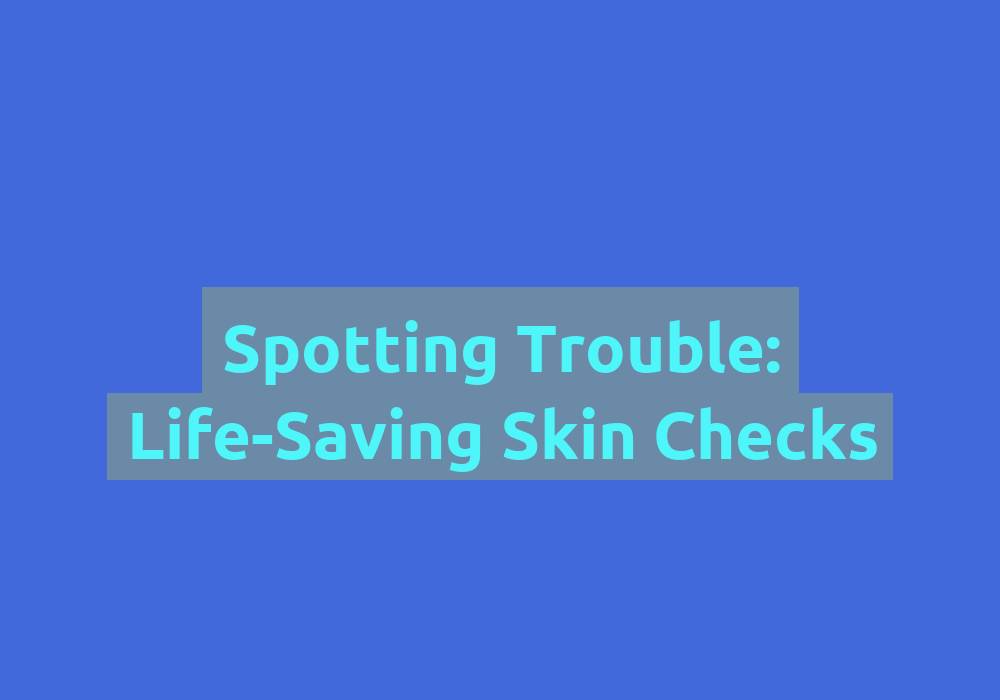Never Skip the Skin Check in Exams

Regularly monitoring and taking care of our skin is crucial for maintaining good overall health. Our skin, the largest organ in our body, serves as a protective barrier against external factors and helps regulate body temperature. Unfortunately, it is also susceptible to various conditions and diseases that can negatively impact our well-being if left unchecked.
In this article, we will explore the importance of regular skin checks during exams and highlight the key reasons why you should never skip this essential step.
The Role of Skin Checks in Preventive Care
Regular skin checks play a vital role in preventive care, enabling early detection and treatment of various skin conditions, including skin cancer. Skin cancer is one of the most common types of cancer globally, but when detected early, it is highly treatable.
By incorporating routine skin checks into your exam schedule, you empower yourself to identify any changes, abnormalities, or signs of potential skin cancer. Early detection greatly increases the chances of successful treatment and reduces the risk of complications associated with advanced-stage skin cancer.
Skin checks also allow for the early identification of other skin conditions, such as eczema, psoriasis, and dermatitis. Detecting these conditions early on can help prevent them from worsening and causing discomfort or pain.
Additionally, regular skin checks can uncover signs of sun damage, such as premature aging and sunspots. By identifying these signs, you can take necessary steps to protect your skin from further damage and maintain its health and appearance.
The Dangers of Ignoring Skin Checks
Failing to perform regular skin checks can lead to serious consequences, such as delayed diagnosis and treatment of skin cancer or other skin conditions. Ignoring these essential exams can result in the progression of diseases, leading to more extensive and invasive treatment procedures.
Skin cancer, if left untreated, can spread to other parts of the body and become life-threatening. By neglecting skin checks, you may miss the opportunity to detect early warning signs and increase the risk of complications associated with advanced-stage skin cancer.
Additionally, neglecting skin checks can contribute to the spread of skin infections or the development of chronic skin conditions. Without proper monitoring, minor skin irritations can worsen, leading to discomfort, pain, and potential complications. Early intervention through regular skin checks can prevent the spread of infections and help manage chronic conditions effectively.
How to Perform a Skin Check
Performing a thorough skin check does not require any specialized equipment or extensive medical knowledge. By following a few simple steps, you can effectively examine your skin for any changes or abnormalities:
-
Choose a well-lit area: Find a location with sufficient lighting, preferably natural light, to ensure optimal visibility. This will help you accurately observe your skin and identify any changes or abnormalities.
-
Undress completely: Remove all clothing to allow for a comprehensive examination of your entire body, including areas that are often overlooked. By undressing completely, you ensure that no area of your skin goes unnoticed during the check.
-
Examine your scalp: Use a hand-held mirror or ask a trusted person for assistance to inspect your scalp thoroughly. Separate your hair to ensure a clear view and pay attention to any moles, lesions, or patches of discoloration. The scalp is often overlooked but can be a common location for skin cancer or other abnormalities.
-
Systematically check your body: Start from the top and work your way down, systematically inspecting your face, neck, chest, arms, hands, legs, feet, and genital area. Take note of any new moles, changes in size or shape, asymmetry, or irregular borders. Ensure you examine all areas of your body, including difficult-to-reach spots, by using mirrors or asking for assistance.
-
Pay attention to your nails: Examine your fingernails and toenails for any discoloration, changes in texture, or growth abnormalities. Changes in the nails can sometimes indicate underlying health issues or fungal infections.
-
Use a full-length mirror: Utilize a full-length mirror to assess areas that may be hard to reach, such as your back and buttocks. Consider using a hand-held mirror or asking for assistance when checking these areas. Remember, skin cancer can occur in areas that receive less sun exposure, so it’s important to thoroughly examine all parts of your body.
-
Don’t forget your soles: Examine the soles of your feet, including the spaces between your toes, and check for any unusual growths, rashes, or changes in color. Skin cancer can also develop on the soles of your feet, so it’s important not to overlook this area.
-
Document any findings: Make a note of any new moles, changes, or abnormalities you observe during the skin check. If possible, take photographs to aid in future comparisons. This documentation will help you keep track of any changes and provide valuable information to healthcare professionals if needed.
When to Seek Medical Advice
While performing regular skin checks is an important part of preventive care, it is crucial to consult a healthcare professional if you notice any concerning changes or abnormalities. Some signs that should prompt you to seek medical advice include:
- A mole that has changed in size, shape, or color: Any significant changes in a mole should be evaluated by a professional.
- An irregular or asymmetrical mole: Moles that are not symmetrical may indicate potential issues.
- A mole with uneven or jagged borders: Uneven or irregular borders can be a sign of skin cancer.
- Any new moles that appear: New moles that suddenly appear should be checked by a dermatologist.
- Moles or lesions that itch, bleed, or crust: These symptoms can be indicative of skin cancer or other skin conditions.
- Skin growths that persist or increase in size: Any growth that doesn’t go away or continues to grow should be examined.
- Persistent redness, swelling, or tenderness: These symptoms may indicate an infection or underlying skin condition.
- Any unusual or concerning skin changes: Trust your instincts. If something seems off or different, consult a healthcare professional.
Remember, early detection and intervention are key to effectively managing and treating skin conditions, including skin cancer. Reach out to a dermatologist or healthcare professional if you have any doubts or concerns.
Conclusion
Regular skin checks during exams should never be overlooked or underestimated. By incorporating these checks into your preventive care routine, you take proactive steps towards maintaining healthy skin and preventing serious conditions. The simple steps provided in this article can help you perform a thorough skin check at home. Remember to seek medical advice if you notice any concerning changes or abnormalities. Never skip the skin check in exams, as the well-being of your largest organ depends on it.
This article is provided in markdown format.
FAQ
1. Why are regular skin checks important?
Regular skin checks are important because they enable early detection and treatment of various skin conditions, including skin cancer. By detecting these conditions early on, you increase the chances of successful treatment and reduce the risk of complications associated with advanced-stage skin cancer.
2. What are the dangers of ignoring skin checks?
Ignoring skin checks can lead to delayed diagnosis and treatment of skin cancer or other skin conditions. It can also contribute to the spread of infections or the development of chronic skin conditions. Neglecting these essential exams can result in more extensive and invasive treatment procedures.
3. How can I perform a skin check at home?
To perform a skin check at home, follow these steps:
- Choose a well-lit area.
- Undress completely.
- Examine your scalp.
- Systematically check your body.
- Pay attention to your nails.
- Use a full-length mirror.
- Don’t forget your soles.
- Document any findings.
4. When should I seek medical advice after a skin check?
You should seek medical advice if you notice any concerning changes or abnormalities during a skin check. Some signs that should prompt you to consult a healthcare professional include significant changes in a mole, irregular or asymmetrical moles, moles with uneven or jagged borders, new moles that appear suddenly, moles or lesions that itch, bleed, or crust, persistent or increasing skin growths, persistent redness, swelling, or tenderness, and any unusual or concerning skin changes.


